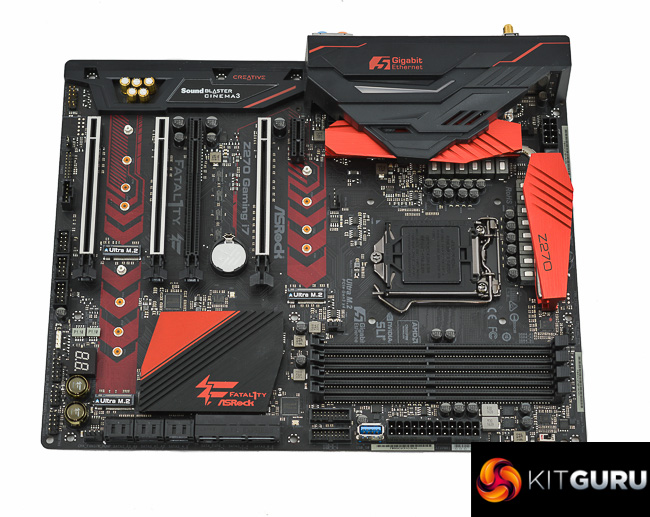
ASRock's Fatal1ty Gaming motherboards likely aren't first to mind for storage and networking connectivity but the new Fata1lty Z270 Professional Gaming i7 is jam packed – three M.2, ten SATA III, three Ethernet ports and AC WiFi .

There's been relatively little pioneering of new connectivity standards for Z270 motherboards since the chipset is loaded as standard with the likes of M.2 NVMe, USB 3.0, USB 3.1, SATA III, PCIe 3.0 and DDR4. This presents no major problems either since that default connectivity covers the vast majority of consumers and Intel's user base for just about anything.
However, ASRock has decided to push the boundaries once again, this time in the realm of networking with the implementation of a 5Gbps network interface controller on the Fatal1ty Z270 Professional Gaming i7. ASRock were, incidentally, one of the first motherboard brands to push 10 Gigabit connections with the X99 WS-E/10G.
The 5Gbps controller will be compatible with a new generation of 5Gbps routers, switches and motherboards spawned from an IEEE standard finalised in late-2016. This new standard will enable 2.5Gbps (over up to 100 metres of Cat 5e cabling) and 5Gbps (over up to 100 metres of Cat 6 cabling) but we've yet to see any consumer-oriented devices take advantage of this yet.
Thankfully, the ASRock board isn't a one trick pony and has a number of other unique selling points, 5Gbps Ethernet aside. These include further networking prowess – dual Intel Gigabit LAN and Intel 802.11ac WiFi and a significant serving of storage potential. ASRock provides three M.2 ports capable of up to 32GB/s each and 10 SATA III ports, though there are naturally bandwidth sharing issues to be aware of when using these concurrently.
ASRock's also ticked other key requirements of a high-end motherboard with a number of handy overclocking buttons and features, a very well fleshed out power delivery system and full RGB lighting capability.
| ASRock Fatal1ty Z270 Professional Gaming i7 | |
| Form Factor | ATX, 30.5 cm x 24.4 cm |
| CPU Socket | LGA 1151, 14 Phase (8+4+2) VRM |
| Chipset | Intel Z270 |
| Memory | DDR4, 4 DIMMs, up to 64GB, up to 3733MHz+ with OC, 2 phase |
| Onboard Graphics | Intel HD Graphics (supported CPUs), up to 1024MB of video memory |
| Discrete Graphics | Up to Nvidia 2-way/Quad SLI, AMD 3-way/Quad CrossFireX |
| Expansion Slots | 4 x PCIe 3.0 (16X/4X/8X/4X electrical – x16/x0, x8/x8, x8/x4/x4) 1 x PCIe 3.0 |
| Storage | 10 x SATA III (6 from PCH, 2 from ASM1061) 2 x SATA Express (Shared with SATA ports 0,1,2,3) 3 x M.2 supporting NVMe 32GB/s* *M2_1 shares bandwidth with SATA 0+1, SATA Express 0 M2_2 shares bandwidth with SATA 4+5 M2_3 shares bandwidth with SATA 3, SATA Express 1 |
| USB | 6 x USB 2.0 (6 Front, via PCH) 9x USB 3.0 (4 Rear, 5 Front, 4 Rear and 1 Front vertical via PCH, Front Headers via ASM1074) 2 x USB 3.1 (2 Rear [Type-A and C], via ASM2142) |
| Networking | 1 x Intel I219V Gigabit 1 x Intel I211AT Gigabit 1 x Aquantia AQC108 5-Gigabit 1 x Intel AC 3160 2T2R 802.11ac WiFi and Bluetooth 4.0 Combo |
| Audio | Realtek ALC 1220, 7.1 Channel |
| Fan Headers | 5, all support 3/4pin fans (2 x CPU, 1 x W_PUMP, 2 x CHA) |
| Rear I/O | 2 x WiFi Antenna Ports 1 x PS/2 Mouse/Keyboard Port 1 x HDMI Port 1 x DisplayPort 1.2 1 x Optical SPDIF Out Port 1 x USB 3.1 Type-A Port 1 x USB 3.1 Type-C Port 3 x USB 3.0 Ports 1 x Fatal1ty Mouse Port (USB 3.0) 3 x RJ-45 LAN Ports with LED 1 x Clear CMOS Switch 5 x HD Audio Jacks |
| UEFI | 2 x 128Mb AMI UEFI |
Be sure to check out our sponsors store EKWB here
 KitGuru KitGuru.net – Tech News | Hardware News | Hardware Reviews | IOS | Mobile | Gaming | Graphics Cards
KitGuru KitGuru.net – Tech News | Hardware News | Hardware Reviews | IOS | Mobile | Gaming | Graphics Cards


